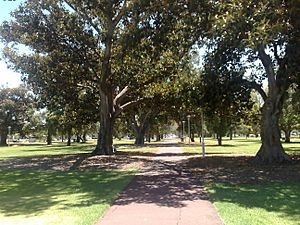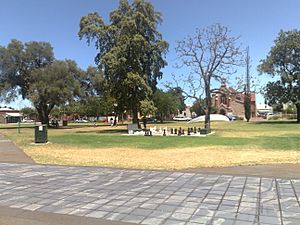Whitmore Square facts for kids
Quick facts for kids Whitmore Square |
|
|---|---|
| Iparrityi | |

From the Southern end, facing North
|
|
| Type | Square |
| Location | Adelaide, South Australia, Australia |
| Area | 2.4 hectares (5.9 acres) |
| Created | 1837 |
Whitmore Square, also known as Iparrityi, is a popular public space in the heart of Adelaide, South Australia. It covers about 2.4 hectares (the size of nearly five football fields!). You can find it where Sturt and Morphett Streets meet, in the city's southwest.
This square is one of six special areas planned by Colonel William Light in 1837. He was the main surveyor who designed the city of Adelaide. The square was first named after William Wolryche-Whitmore, a British politician. He helped create the law that started the colony of South Australia. In 2003, it also received a second name, Iparrityi. This name comes from the Kaurna language, spoken by the original Aboriginal people of the Adelaide area. Iparrityi was also the name of a very important Kaurna woman, Amelia Taylor, who was one of the last people to speak the Kaurna language fluently.
Contents
Exploring Whitmore Square's Past
Early Days and Kaurna Heritage
Long before European settlers arrived in 1836, the land where Adelaide now stands was home to the Kaurna people. They lived on and cared for this land for thousands of years.
How Whitmore Square Got Its Name
Whitmore Square is special because it still looks much like it did in Colonel William Light's original 1837 city plan. Light wanted these squares to be open public parks or village greens for everyone to enjoy.
The Street Naming Committee officially named the square on May 23, 1837. It was named after William Wolryche Whitmore, a British politician. He was important because he introduced the South Australia Act 1834 to the British Parliament. This law was also known as the Foundation Act because it set up the colony of South Australia.
Changes Over the Years
When the city was first settled, many of the native trees in the square were removed. But in the 1850s, new trees were planted. Fences were put up to protect the plants from animals, but these fences were taken down in 1932. In the 1930s, the square became a popular spot for people to meet and talk about the news. It was also a fun place for local children to play.
During World War II, the square was used for training soldiers. Trenches were dug there to practice for air raids. From 1909 to 1958, electric tram tracks actually cut through the northwest corner of the square.
The Dual Naming Project
In March 2003, the square received its second name, "Ivaritji." This was part of a project by the City of Adelaide to give places dual names, using both English and Kaurna names. The spelling was later changed to Iparrityi.
This name honors a significant Kaurna woman, Iparrityi, also known as Amelia Taylor. She was born in the 1840s near Port Adelaide. She is remembered as one of the last people of full Kaurna heritage and a fluent speaker of the Kaurna language. The Kaurna word "Iparrityi" means "gentle, misty rain."
Whitmore Square Today
A Welcoming Community Space
By the 1990s, the square had become less popular. To make it a safer and more enjoyable place, changes were made. In 2007, a giant chess board was added, and a basketball half-court followed in 2009. The square has now become a more "community-focused park." There's even a Community Verge Garden on the western side. Many events are now held here, like food truck festivals and outdoor movie nights.
Art and History in the Square
In December 2007, a public artwork called Voyagers was put up on the western side of Whitmore Square. This artwork remembers the Afghan cameleers. These cameleers lived nearby and visited the Central Adelaide Mosque when they weren't working in the Australian outback.
New Life for the Area
The area around Whitmore Square has seen a lot of new energy in the 2010s. Several new cafes have opened, making it a lively place. In September 2018, the historic Whitmore Hotel reopened as Sparkke at the Whitmore. This happened after a local brewing company bought the building.
The City of Adelaide has also approved a new plan for the square, called the Whitmore Square/Iparrityi Master Plan. This plan was decided after talking with the community in June 2019. New lights have already been installed along the paths and on some of the trees, making the square even more inviting.


